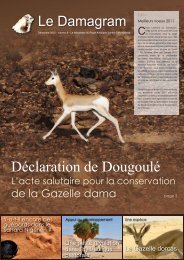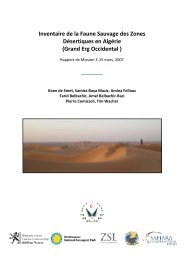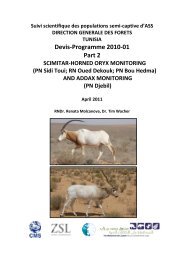The Biology, Husbandry and Conservation Scimitar-horned Oryx ...
The Biology, Husbandry and Conservation Scimitar-horned Oryx ...
The Biology, Husbandry and Conservation Scimitar-horned Oryx ...
You also want an ePaper? Increase the reach of your titles
YUMPU automatically turns print PDFs into web optimized ePapers that Google loves.
31<br />
Part 2: <strong>Husb<strong>and</strong>ry</strong> Guidelines<br />
• Pellets should be fed to lactating females with very young offspring, however, the amount<br />
should be reduced if the calves start scouring (E. Flach pers comm.).<br />
• High protein levels in feed concentrates have been associated with excessive hoof growth<br />
<strong>and</strong> diarrhoea. <strong>The</strong> latter has also been reported in animals returned to pasture following<br />
prolonged periods without grazing.<br />
• <strong>The</strong> occasional case of copper <strong>and</strong> magnesium deficiency have been reported, but<br />
otherwise mineral imbalances do not appear to be widespread.<br />
See section 15, this volume for further information on nutritional causes of disease.<br />
Summary of Dietary Recommendations for <strong>Scimitar</strong>-<strong>horned</strong> <strong>Oryx</strong><br />
With no available information on the composition of the natural diet for the scimitar-<strong>horned</strong><br />
oryx, current dietary recommendations are based on apparently successful feeding regimes in<br />
EEP institutions <strong>and</strong> requirements for domestic grazing ruminants:<br />
• Bulk diet should consist of grass hay ad libitum with provision of appropriate feed<br />
concentrates to meet additional nutritional requirements (Oftedal et al., 1996). Quantities<br />
depend on access to pasture <strong>and</strong> should be adjusted if the animals become overweight.<br />
While some mobilisation of body stores is desirable in winter to duplicate natural<br />
seasonal trends, body condition should be monitored <strong>and</strong> diet adjusted if necessary.<br />
• Use of browse in moderation may be beneficial, but should not be a major component of<br />
the diet.<br />
• Feeding of fruit <strong>and</strong> vegetables should not be necessary, but if included in the diet should<br />
be used sparingly.<br />
• Supplementing the diet with additional vitamins <strong>and</strong> minerals should be in line with the<br />
requirements for domestic livestock. Salt licks should be available at all times.<br />
• Fresh, clean water should be provided at all times.<br />
H<strong>and</strong>-rearing <strong>Scimitar</strong>-<strong>horned</strong> <strong>Oryx</strong> Calves<br />
H<strong>and</strong> rearing of scimitar-<strong>horned</strong> oryx calves should only occur in exceptional circumstances<br />
when it is absolutely clear that the calf will not survive without human intervention. Only<br />
seven (out of 22) EEP zoos that replied to the husb<strong>and</strong>ry questionnaire reported that their<br />
institution had experience of h<strong>and</strong>-rearing oryx calves. Given the limited experience of EEP<br />
institutions, <strong>and</strong> reports on h<strong>and</strong> rearing oryx, it is difficult to make precise recommendations,<br />
<strong>and</strong> the following information should serve only as a guide.<br />
EEP zoos have reported feeding scimitar-<strong>horned</strong> oryx calves on goat, cow <strong>and</strong> sheep’s milk.<br />
At Marwell, h<strong>and</strong> reared calves were originally fed on cow’s milk, but this frequently resulted<br />
in bouts of diarrhoea. As a result, any orphaned or rejected calves are now fed on goat’s milk<br />
which appears to be more suitable for their digestive system. See table 5 for a nutritional<br />
comparison of different milks. Both raw eggs <strong>and</strong> vitamin powder can be added to the milk,





